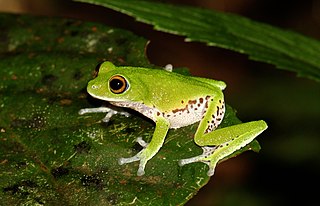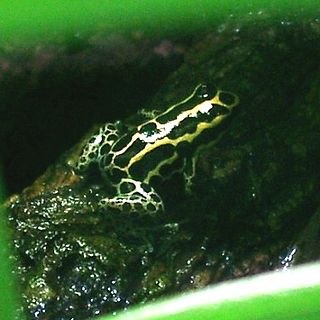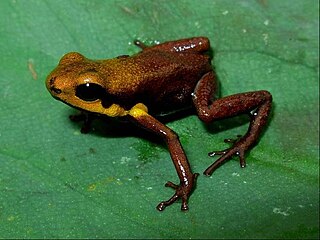
Indirana leithii is a species of frog in the family Ranixalidae. It is endemic to the northern Western Ghats of India. As currently defined, its range is restricted to the states of Maharashtra and southern Gujarat; earlier records elsewhere refer to other species.
Leucostethus argyrogaster or the Imaza rocket frog is a species of frog in the family Dendrobatidae. It is endemic to Peru.
Hyloxalus sylvaticus is a species of frog in the family Dendrobatidae. It is endemic to northern Peru and found on the Amazonian slopes of the Eastern Andes and in the Huancabamba Depression. Its range might extend to Ecuador.

The Cauca poison frog is a species of frog in the family Dendrobatidae. It is endemic to Colombia.

Andinobates claudiae is a species of frog in the family Dendrobatidae. It is endemic to Panama.

The blue-bellied poison frog or bluebelly poison frog is a species of frog in the family Dendrobatidae.

The Andean poison frog is a species of frog in the family Dendrobatidae. It is endemic to Colombia.

Andinobates virolinensis is a species of frog in the family Dendrobatidae. It is endemic to Colombia where it is confined to the Santander and Cundinamarca departments on the Cordillera Oriental.
Cruziohyla craspedopus, the fringed leaf frog or fringed tree frog, is a species of frog in the subfamily Phyllomedusinae. It is found in the Amazonian lowlands in Brazil, Colombia, Ecuador, and Peru, and possibly in Bolivia.

Pseudophilautus mooreorum, commonly known as Moore's shrub frog, is a species of frog in the family Rhacophoridae. It is endemic to Sri Lanka.

Ranitomeya is a genus of dart poison frogs found in Panama and South America south to Peru and Brazil, possibly into Bolivia.
Gracixalus quangi is a species of bush frog endemic to Vietnam, Laos, and China, where it has been observed between 550 and 1300 meters above sea level.
Hyloxalus maculosus, also known as spotted rocket frog, is a species of frogs in the family Dendrobatidae. It is endemic to the eastern slopes of Ecuadorian Andes in Napo and Pastaza provinces at elevations of 342 to 1,225 m asl.

Andinobates dorisswansonae, the dotted poison frog, is a species of amphibian in the family Dendrobatidae, endemic to Colombia in the outskirts of Falan and north of the department of Tolima. It is toxic to humans.

Andinobates tolimensis, the Tolimense poison frog, is a species of amphibian in the family Dendrobatidae, endemic to Colombia in the outskirts of Falan and north of the department of Tolima. Previously it was included in the genus Ranitomeya, but was reclassified in Andinobates, along with 11 other species. It is threatened by habitat loss. It is toxic to humans and when captured will excrete a milky substance.
Hyloxalus aeruginosus is a species of poison dart frog endemic to Peru.
Ranitomeya toraro, the Apuriná poison frog, is a species of frog in the family Dendrobatidae. It is endemic to Colombia and Brazil and possibly nearby Peru.
Hyloxalus spilotogaster is a species of frog in the family Dendrobatidae. It is known from a single specimen found in Peru.
Hyloxalus sordidatus is a species of frog in the family Dendrobatidae. It is endemic to Peru.
Hyloxalus craspedoceps is a species of frog in the family Dendrobatidae. It lives in Peru.










